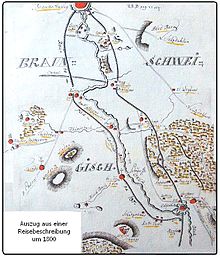Rudolf August (Braunschweig-Wolfenbüttel)


Rudolf August (born May 16, 1627 in Hitzacker ; † January 26, 1704 in Hedwigsburg ) was Duke of Braunschweig and Lüneburg and from 1666 until his death Prince of Braunschweig-Wolfenbüttel .
Life
Rudolf August was the eldest son of Duke August the Younger and Dorothea von Anhalt-Zerbst (1607–1634), daughter of Rudolf von Anhalt-Zerbst .
In 1666 he succeeded his father as Duke of Braunschweig-Lüneburg and Prince of Braunschweig-Wolfenbüttel . However, Rudolf August devoted himself more to his studies and hunting. He had an extensive library set up and in 1663 his father had appointed him “Jägermeister”. But even before he took office, he proved that he wanted to help the citizens. According to his ordinance of December 24, 1660, he released the Calvörder to obtain the necessary construction and firewood from the Calvörde forest .
In 1667, one year after taking office, he appointed his younger, power-conscious brother Anton Ulrich (1633–1714) as governor . Rudolf August withdrew more and more from the government business that he left to his brother. In 1671 Rudolf August and Anton Ulrich succeeded in occupying the city of Braunschweig after about three weeks of siege. This ended the era of the independent city of Braunschweig. In 1685 he appointed Anton Ulrich Duke and co -regent with equal rights .
In 1650 he married Countess Christiane Elisabeth von Barby (1634–1681). The couple had three daughters, one of whom died before their first birthday. To ensure family succession, the dukes agreed in 1681 that Rudolf August's daughter Christine Sophie (1654–1695) would marry her cousin August Wilhelm (1662–1731), son of Anton Ulrich. August Wilhelm therefore succeeded his father Anton Ulrich in 1714, who in 1704, after the death of Rudolf August, had assumed sole rule.
Rudolf August himself married in the same year, on June 7 and July 7, 1681, a few weeks after the death of his first wife Christiane Elisabeth, in morganatic marriage , the eighteen-year-old Rosine Elisabeth Menthe (1663-1701), daughter of a barber and Surgeon. The marriage remained childless.
During his 38-year reign, Rudolf August developed brisk construction activity. After 1671 he had a path built through the Lechlumer Holz between Wolfenbüttel and Braunschweig, today a section of the federal road 79 as the "Neuer Weg" . This so-called “Herrschaftliche Weg” ran parallel to the old trade route (“Alter Weg”) in a straight line from the later pleasure palace Antoinettenruh via the baroque palace, later known as the “Sternhaus”, to the Großer Weghaus in Stöckheim .
In the years 1695–1702 he had the fortress builder Caspar Völker (1655–1730) build the Seesen court and castle church of St. Andreas. The elaborate interior, the organ and the excellent acoustics of the church are remarkable.
For Rosine Elisabeth, the Duke had the moated castle in Vechelde near Braunschweig converted into a princely country castle in Vechelde in 1695 , probably by the master builder Hermann Korb (1656–1735) .
Rudolf August donated his private library, the Bibliotheca Rudolphea , to the Helmstedt University Library in 1702, two years before his death . In doing so, he ensured a significant expansion of the Bibliotheca Julia .
He was accepted as a member of the Fruitful Society under the company name Der Nachsinnende .
The political situation that led to the separation from his brother, i.e. to the end of the community government, is unique in its extensive historical depiction in the coin image of the commemorative taler "on the separation of fraternal unity" . His brother Anton Ulrich had a commemorative coin minted in 1702 on the separation of unity, which shows Guericke's attempt to prove the effect of air pressure and interpreted it politically: The cellic and Hanoverian horse try in vain to break fraternal unity until a treacherous hand this unity destroyed.
Rudolf August died on January 26, 1704 at Hedwigsburg Castle , south of Wolfenbüttel.
Marriages and offspring
⚭ 1. 1650 Countess Christiane Elisabeth von Barby (1634–1681).
- Dorothea Sophie (1653–1722), from 1673 married to Johann Adolf , Duke of Holstein-Plön.
- Christine Sophie (1654–1695), from 1681 married to Duke August Wilhelm von Braunschweig (1662–1731).
- Eleonore Sophie (1655-1656).
⚭ 2. 1681 Rosine Elisabeth Menthe (1663–1701), childless.
literature
- Jochen Bepler : Rudolf August, Duke of Braunschweig and Lüneburg (Wolfenbüttel). In: Horst-Rüdiger Jarck , Dieter Lent et al. (Ed.): Braunschweigisches Biographisches Lexikon - 8th to 18th century . Appelhans Verlag, Braunschweig 2006, ISBN 3-937664-46-7 , p. 598 f .
- Paul Zimmermann : Rudolf August . In: Allgemeine Deutsche Biographie (ADB). Volume 29, Duncker & Humblot, Leipzig 1889, pp. 525-529.
Individual evidence
- ↑ Rudi Fischer: 800 years Calvörde - a chronicle up to 1991. The forest in the district office.
- ^ Paul Zimmermann : Rudolf August . In: Allgemeine Deutsche Biographie (ADB). Volume 29, Duncker & Humblot, Leipzig 1889, pp. 525-529.
- ↑ Karl Eduard Vehse : History of the courts of the House of Braunschweig, 5th part, The court holdings in Hanover, London and Braunschweig. Verlag Hoffmann and Campe, Hamburg 1853, p. 169.
- ^ Wilhelm Bornstedt : The Braunschweiger Barockstraße between Braunschweig and Wolfenbüttel around 1800. In: Preservation of monuments and history (building blocks of the town house keeper). Volume 25, Braunschweig 1984.
- ↑ Johann David Köhler: Historischer Münz-Amustigung published weekly in 1729 . Volume 16, 41. 42nd piece, 1744 p. 321.
Web links
- Literature by and about Rudolf August in the catalog of the German National Library
- Works by and about Rudolf August in the German Digital Library
- Publications by and about Rudolf August in VD 17 .
| predecessor | Office | successor |
|---|---|---|
| August the Younger |
Prince of Braunschweig-Wolfenbüttel 1666–1704 |
Anton Ulrich |
| personal data | |
|---|---|
| SURNAME | Rudolf August |
| BRIEF DESCRIPTION | Duke of Brunswick |
| DATE OF BIRTH | May 16, 1627 |
| PLACE OF BIRTH | Hitzacker |
| DATE OF DEATH | January 26, 1704 |
| Place of death | Hedwigsburg |


